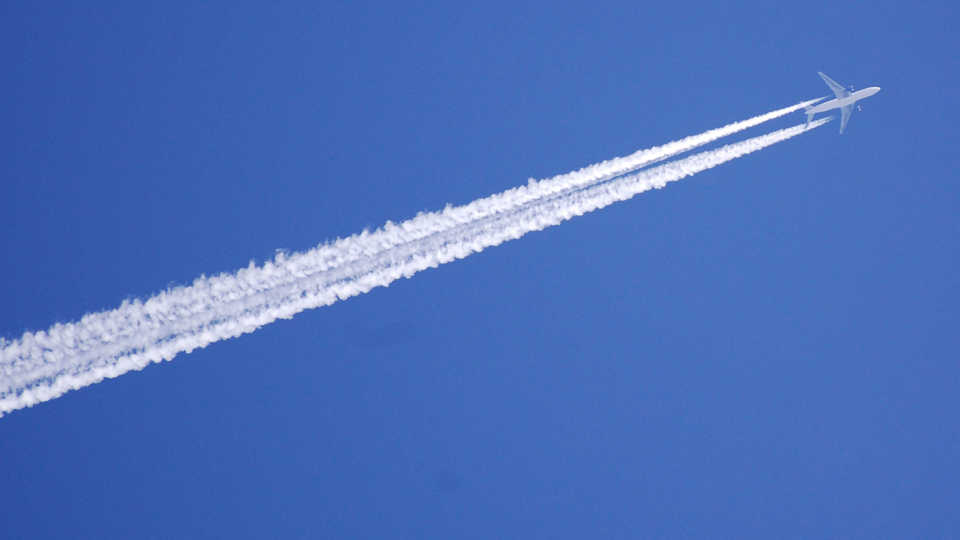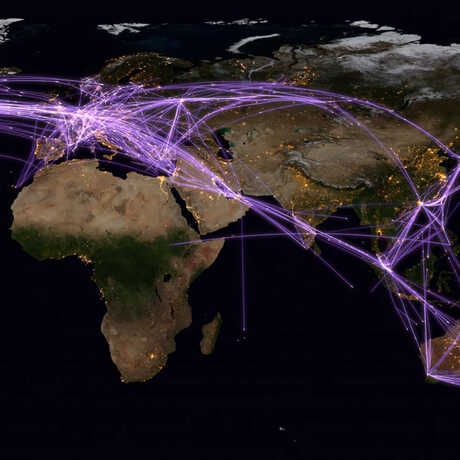Browse a rich array of educational resources from the award-winning show, Habitat Earth.
How can we minimize our carbon emissions while traveling?

© Claudia Daggett
The connectivity of regions around the globe made possible by air travel and other transportation modes comes with environmental costs, such as increased carbon emissions from the burning of fossil fuels. In this activity, students will be transformed into strategically low-impact world travelers.
How can we minimize our carbon emissions while traveling?
Students will

It is recommended that you introduce your students to the environmental effects of burning fossil fuels, how humans have changed the concentration of carbon dioxide in the atmosphere over time, and why we care prior to integrating this activity into your classroom. Here are some helpful resources and activities:
Competition Overview
Competition Rules and Details
Encourage the groups to keep their plans confidential—remind them that it is a competition!
We use fossil fuels for most of our energy needs today. In 2012, fossil fuels like coal, natural gas, and oil accounted for 87% of global primary energy consumption (Gonzalez & Lucky, 2013). In 2013, the burning of petroleum-based fuels to power various modes of transportation, including cars, trucks, trains, ships, and planes, accounted for 27% of total greenhouse gas emissions in the United States (US EPA, 2015).
The burning of fossil fuels has increased the levels of heat-trapping greenhouse gases in the atmosphere since pre-industrial times. Carbon dioxide is a greenhouse gas that occurs naturally in the Earth’s atmosphere as part of the carbon cycle. The natural greenhouse effect keeps the Earth warm enough to sustain life, but human activities are amplifying this effect. Some of the potential effects of global climate change are an increase in wildfires, longer periods of drought, and an increase in the duration and intensity of tropical storms. The rising temperature will also cause a rise in sea level due to the melting of glacial ice and the thermal expansion of warmer seawater, which in turn will cause flooding in coastal areas. (NASA, retrieved August 2015).
The connectivity of countries around the globe made possible by air travel and other forms of transportation comes at an environmental cost. Tourism accounts for more than 60% of air travel (UNEP, retrieved July 2015), and is responsible for about 5% of global carbon dioxide emissions (UNWTO, 2008). Some air traffic forecasts project as much as a 500% increase in air traffic carbon emissions by 2050 (Lee et al., 2013).
Increasing concerns about the impacts of global travel on energy consumption and the environment has inspired a movement towards more sustainable and eco-friendly tourism. Organizations like the Union of Concerned Scientists have released data and published reports that not only compare the carbon footprints of various modes of transportation, but also share information about how one can decrease his or her own carbon footprint while traveling (Union of Concerned Scientists, 2008). In the world of aviation technology and engineering, companies like Boeing and Pratt are working towards designing more aerodynamic airplane and more fuel efficient engines to minimize both costs and emissions (Gross, 2013).
Disciplinary Core Ideas (6-8)
Science and Engineering Practices (6-8)
Cross-Cutting Concepts (6-8)
Planefinder.net
Pinkfroot, LTD
Gonzalez, M. & Lucky, M. (2013) Fossil Fuels Dominate Primary Energy Consumption. Worldwatch Institute. Retrieved August 2015 from http://www.worldwatch.org/fossil-fuels-dominate-primary-energy-consumption-1
Gross, T.K. (2013) Reshaping Flight for Fuel Efficiency: Five Technologies on the Runway. National Geographic. Retrieved August 2015 from http://news.nationalgeographic.com/news/energy/2013/04/130423-reshaping-flight-for-fuel-efficiency/
Lee, D.S., Lim, L.L. & Owen, B. (2013) Bridging the Aviation CO2 Emissions Gap: Why Emissions Trading is Needed. Manchester Metropolitan University, Centre for Aviation Transport and the Environment. Retrieved August 2015 from: http://www.cate.mmu.ac.uk/projects/bridging-the-aviation-co2-emissions-gap-why-emissions-trading-is-needed/
NASA (n.d.). The current and future consequences of global change. Retrieved August 2015 from http://climate.nasa.gov/effects/
Sightline Institute (n.d.). How Low-Carbon Can You Go: The Green Travel Ranking. Retrieved July 2015 from http://www.sightline.org/research/graphics/climate-co2bymode/
Union of Concerned Scientists (2008). Getting There Greener: The Guide to Your Lower-Carbon Vacation. Cambridge, MA: UCS Publications. http://www.ucsusa.org/sites/default/files/legacy/assets/documents/clean_vehicles/greentravel_report.pdf
United States Environmental Protection Agency (U.S. EPA) (2015). U.S. Greenhouse Gas Inventory Report: 1990-2013. http://www.epa.gov/climatechange/emissions/usinventoryreport.html
United Nations Environment Programme (UNEP) (n.d.). Tourism’s Three Main Impact Areas. Retrieved July 2015 from http://www.unep.org/resourceefficiency/Business/SectoralActivities/Tourism/FactsandFiguresaboutTourism/ImpactsofTourism/EnvironmentalImpacts/TourismsThreeMainImpactAreas/tabid/78776/Default.aspx
UNWTO (2008) Climate Change and Tourism: Responding to Global Challenges. Madrid, Spain: World Tourism Organization and United Nations Environment Programme.
Browse a rich array of educational resources from the award-winning show, Habitat Earth.